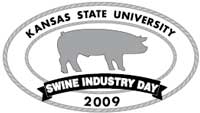



Kansas Researchers Seek Best Option for Topping
Topping is the removal and marketing of the heaviest animals from a pen of finishing pigs. The practice improves growth performance of the remaining pigs, and topping two pigs once is the best option, according to a paper by Jacela and others presented at Kansas Swine Day 2009.
The economic impact of removing the heaviest pigs (topping) before marketing a finishing group and the effect of topping on performance of the remaining pigs were determined in two studies, explained J.Y. Jacela of the College of Veterinary Medicine at Kansas State University and co-authors from the same university.
In Experiment 1, a total of 1,126 pigs (bodyweight = 241 lb; 25 pigs per pen) were randomly assigned to one of three treatments: topping 0, two or four pigs per pen 15 days before marketing the remaining pigs in the group.
After topping, floor space per pig was 7.2, 7.8 and 8.6 square feed for pens with 0, two and four pigs topped per pen, respectively.
Overall (days 0 to 15), increasing the number of pigs topped per pen improved average daily gain (ADG; P<0.02), average daily feed intake (ADFI; linear; P<0.03) and feed conversion (F/G; quadratic; P<0.04). Revenues were similar (P>0.76) for all treatments but feed usage and cost was reduced (quadratic; P<0.01) as more pigs were topped per pen. However, there was no impact on income over feed cost (IOFC).
In Experiment 2, a total of 1,084 pigs (bodyweight = 234 lb; 27 pigs per pen) were assigned to one of five treatments. On day 0 (20 days before close-out), two pigs were topped from each pen excluding the control pens (0 top). Pens that were topped at day 0 had an additional 0, two, four or six pigs per pen topped on day 10. Floor space per pig was 6.7 square feed in control pens and 7.2 square feed for the remaining pens from days 0 to 10. After topping on day 10, floor space per pig was 7.8, 8.6, and 9.5 square feet for pens with two, four or six more pigs topped, respectively.
From days 10 to 20, the remaining pigs had increased (linear; P<0.01) ADFI, which led to a linear increase (P<0.01) in ADG. Overall, ADG and ADFI increased (linear; P<0.05) with increasing number of pigs topped, and F/G improved (P<0.01) in topped pens relative to intact pens.
Weight discounts were higher in intact pens (P<0.02) than topped pens. Revenue decreased (P<0.05) as additional pigs were topped after day 10 in pens topped at day 0.
Feed usage was highest (P<0.01) in intact pens. As more pigs were topped on day 10, IOFC tended to decrease (P=0.07).
Topping, regardless of number of pigs, did not affect (P>0.23) any of the carcass traits measured.
Jacela and co-authors concluded that topping improves growth performance of the remaining pigs. Based on IOFC, topping two pigs once is the best option. Improvements in performance from topping more than two pigs were not great enough to overcome the reduction in total weight produced by the pen.
References
Jacela J.Y., S.S. Dritz, M.D. Tokach, J.M. DeRouchey, R.D. Goodband and J.L. Nelssen. 2009. Economic impact of removing pigs before marketing on the remaining pigs' growth performance. Proceedings of the Kansas Swine Day 2009, 262-269.
Further Reading
| - | You can view the full paper by clicking here. |
Further Reading
| - | You can find other papers presented at the Kansas Swine Day 2009 by clicking here. |
June 2010








